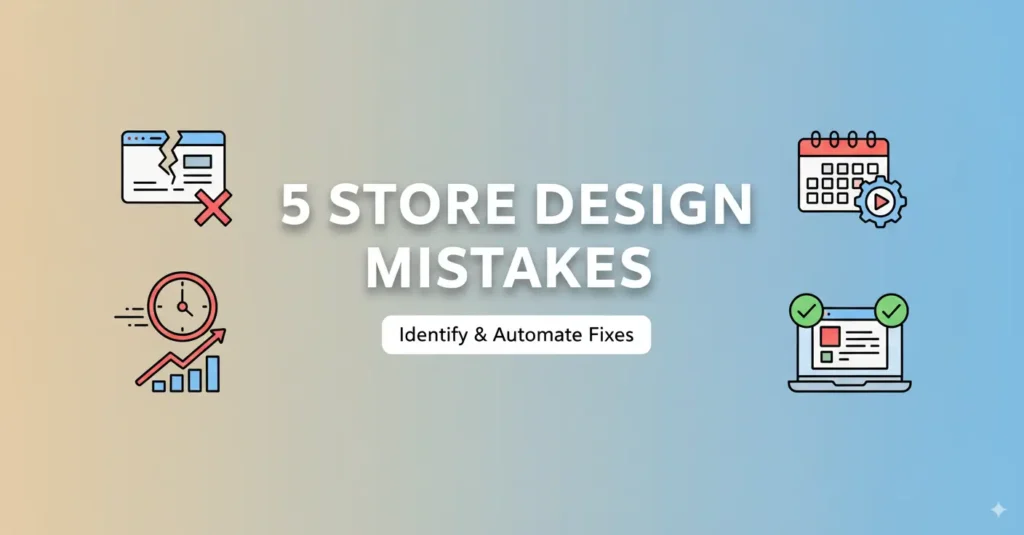
Top 5 Mistakes Shopify Merchants Make with Store Design (And How to Fix Them)
A beautiful, functional, and up-to-date Shopify store isn’t just nice to have – it’s crucial for converting visitors into customers. Yet, many merchants fall into common design traps that hinder their success. Often, these issues stem from relying too heavily on manual processes and delaying necessary updates. Let’s dive into the mistakes and, more importantly, how to fix them with a focus on automation.
Mistake 1: Inconsistent Branding Across the Store
The Problem: Visitors landing on different pages of your store might encounter varying fonts, color palettes, or image styles. This lack of cohesion creates a disjointed and unprofessional experience, eroding trust. This usually happens because different sections are updated manually by various team members or at different times, leading to style drift.
How Manual Edits & Late Updates Contribute:
- Manual Edits: Without a centralized style guide or a system to enforce it, individual page edits can introduce new styles that clash with existing ones. A marketing banner added one week might use a different shade of your brand color than the product page updated the next.
- Late Updates: If your brand guidelines evolve, but updates to older pages are delayed, new pages will reflect the current brand while older ones remain outdated, leading to inconsistency.
The Fix:
- Theme Customizer & Global Styles: Utilize Shopify’s theme customizer to set global fonts, colors, and button styles. This ensures consistency across all pages built with the theme.
- Automation: For dynamic content like banners or promotions, consider apps that allow you to create templates or global content blocks. Changes made to these blocks automatically propagate across all pages where they are used. Implement a system where all content pushed to the live site undergoes a quick automated brand consistency check.
- Standard Operating Procedures (SOPs): Document your brand guidelines clearly and train all team members involved in content creation and design on these standards.
Mistake 2: Slow Page Load Times Due to Unoptimized Assets
The Problem: Nothing drives a potential customer away faster than a slow-loading page. Large, unoptimized images and excessive apps can significantly bloat your page size, leading to high bounce rates and poor SEO performance. This is almost always a result of manual image uploads without prior optimization or neglecting to regularly audit app performance.
How Manual Edits & Late Updates Contribute:
- Manual Edits: Merchants often upload high-resolution images directly from their cameras or design software without compressing or resizing them for web use. This is a manual oversight repeated daily.
- Late Updates: Neglecting to regularly audit and remove unused or redundant apps, or failing to compress older images, means your store slowly accumulates performance-draining elements over time.
The Fix:
- Image Optimization Automation: Use Shopify apps that automatically compress and resize images upon upload. Many also convert images to modern formats like WebP. Make this an automated step in your content pipeline.
- Lazy Loading: Ensure your theme supports lazy loading for images and videos, so media only loads when it enters the user’s viewport.
- Regular App Audits: Schedule quarterly reviews to remove any apps you no longer use or that are significantly impacting your store’s speed. Tools exist to monitor app performance.
- Automation: Integrate a content delivery network (CDN) for faster asset delivery globally.
Mistake 3: Poor Mobile Responsiveness
The Problem: A significant portion of online shopping now happens on mobile devices. If your store isn’t fully responsive – meaning it doesn’t adapt gracefully to different screen sizes – you’re losing sales. Text may be too small, buttons unclickable, or layouts broken, leading to frustration and abandonment. Merchants sometimes make manual tweaks for desktop without checking mobile, or updates to the theme aren’t fully tested for responsiveness.
How Manual Edits & Late Updates Contribute:
- Manual Edits: Developers or designers might focus primarily on the desktop view when making manual code adjustments, overlooking how these changes render on smaller screens.
- Late Updates: If your theme is old or hasn’t been updated in a while, it might not fully support the latest responsive design best practices, or custom sections might break with new mobile devices.
The Fix:
- Choose a Responsive Theme: Start with a modern Shopify theme that is inherently responsive. Most current themes are designed this way.
- Thorough Testing: Always test your store’s design on various devices and screen sizes. Use Shopify’s theme customizer preview modes (desktop, tablet, mobile) and external tools like Google’s Mobile-Friendly Test.
- Automation: Implement automated testing tools that check for responsiveness issues whenever new content or design changes are deployed. This catches problems before they go live.
- Prioritize Mobile-First Design: When designing new sections or layouts, think “mobile-first.”
Mistake 4: Outdated or Stale Content and Promotions
The Problem: Customers expect fresh content, new products, and timely promotions. A store that looks like it hasn’t been updated in months signals neglect and can deter repeat business. Banners promoting past sales, old blog posts front and center, or product descriptions that haven’t been refreshed can all contribute to a stale feel. This is almost exclusively due to manual updates being forgotten or pushed down the priority list.
How Manual Edits & Late Updates Contribute:
- Manual Edits: Setting up new banners, updating homepage sections, or rotating product highlights often requires manual intervention. If busy merchants don’t schedule or prioritize these tasks, they get missed.
- Late Updates: Promotional banners are left up past their expiration date because someone forgot to manually take them down. Product collections aren’t updated to reflect seasonal trends, and blog content grows old.
The Fix:
- Scheduled Content Updates (Automation): Use apps or built-in Shopify features that allow you to schedule content publication and unpublication. For example, schedule a “Summer Sale” banner to go live on a specific date and then automatically disappear when the sale ends.
- Dynamic Collections: Utilize Shopify’s automated collections based on tags, product types, or inventory levels to ensure your “New Arrivals” or “Sale Items” sections are always current without manual intervention.
- Marketing Automation: Integrate email marketing and social media scheduling tools to align your store updates with your external marketing efforts, ensuring a consistent message.
- Automated Product Feeds: For specific product showcases, use apps that pull in trending or best-selling products dynamically.
Mistake 5: Neglecting A/B Testing for Design Elements
The Problem: Many merchants stick with a design because it “looks good” or because it’s what they initially set up. They fail to test different layouts, call-to-action (CTA) button colors, product image arrangements, or navigation structures. This means they’re likely leaving conversions on the table because they haven’t optimized based on actual user behavior. This is a classic case of not knowing what to change, or not having the time to manually implement and track multiple variations.
How Manual Edits & Late Updates Contribute:
- Manual Edits: Manually creating different versions of a page, deploying them, and then trying to track their performance is incredibly time-consuming and prone to error.
- Late Updates: Even if a merchant knows they should A/B test, the perceived effort of manually implementing tests and analyzing results can lead to continuous postponement.
The Fix:
- A/B Testing Apps (Automation): Integrate Shopify apps designed for A/B testing. These tools allow you to create different variations of pages or elements, split traffic between them, and automatically track which version performs better based on your defined goals (e.g., conversions, add-to-carts).
- Heatmaps & Session Recordings: Use tools that provide visual data on how users interact with your store. This informs where design changes might be most effective.
- Data-Driven Design Decisions: Instead of guessing, let data from A/B tests guide your design improvements. Automate the collection and presentation of this data so you can make informed decisions quickly.
By recognizing these common pitfalls and actively seeking automation solutions, Shopify merchants can transform their store design from a manual chore into a streamlined, high-performing asset that consistently drives sales and enhances the customer experience.

